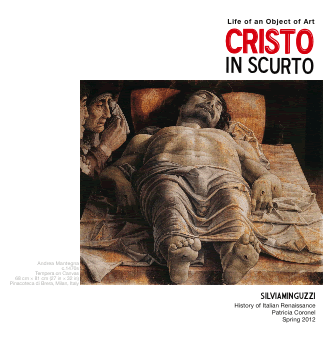 |
||||||||||||||||||||
 |
||||||||||||||||||||
|
During the Renaissance a new notion of the individual was created. This identity was formed through knowledge based on the relationship of the individual to the world in which they lived. At the time, new forms of knowledge were being pursued and old ones were being questioned or repositioned. The debate over the relationship of past and present knowledge of the divine or ‘ideal’ to science and nature changed the way that people viewed themselves. Individual identity is constructed in Andrea Mantegna’s Lamentation over the Dead Christ through the confrontation of different forms of knowledge. The body of Christ is the place where knowledge is deposited and discussed. At one time this figure is a depiction of God and the ideal body while at the same time it shows the mortality of the human being. Andrea Mantegna was aware of the new consciousness about the individual. The evidence that exists in Mantegna’s paintings has lead many art historians to conclude that he was one of the leading historical thinkers of his time. At this time the notion of the ‘ideal’ body was strongly held by those artists who depicted the human figure. These notions also changed the relationship of artists to the divine in their depictions. God was seen as being more personal to each individual. It is against this backdrop that around 1480 Mantegna painted the Lamentation over the Dead Christ. |

 Download the paper
Download the paper